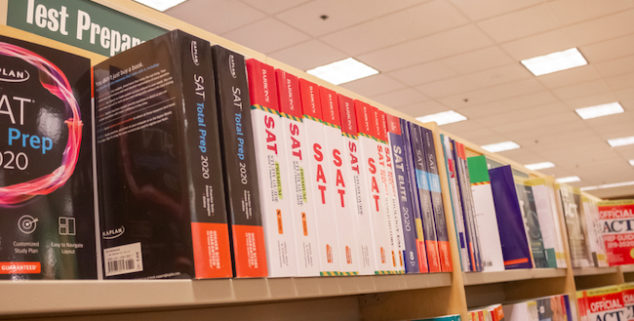Opinion
The SAT is helping minorities succeed
 Materials for preparing for the SATs on a shelf at a Laguna Niguel book store. (Photo: David Tonelson, via Shutterstock)
Materials for preparing for the SATs on a shelf at a Laguna Niguel book store. (Photo: David Tonelson, via Shutterstock)As a proud first-generation American, I have a deep personal connection to the one thing that helps create opportunities for people from all backgrounds: education.
When my parents immigrated to the U.S. from Colombia with limited financial resources, they understood the power that education has to change lives. Yet, the doors to my future were only truly opened when I took the PSAT/NMSQT, which helps students prepare for the SAT, qualifies them for National Merit Scholarships, and is connected with hundreds of colleges and many scholarship opportunities I never would have known about had I not taken the test.
There are those who claim that the SAT itself is biased or in some way disadvantages underrepresented and low-income students. That just isn’t true.
Now I have the privilege of helping to provide those same educational opportunities to young people all over the country as the leader of the College Board division that administers the PSAT-related assessments and SAT to millions of students each year. Our mission as a not-for-profit is to help students pursue their college dreams by connecting them to hundreds of millions of dollars in scholarships.
In fact, the College Board works with 19 national scholarship partners, including the Hispanic Scholarship Fund, the Jackie Robinson Foundation, Indigenous Education, Inc. and more, to help diverse and promising students earn scholarships that make all the difference in their ability to go to college.
In 2019, $33 million in scholarships was awarded to students from underrepresented backgrounds through College Board partnerships. And we’re committed to growing those numbers every year.
Many of these students, like me, wouldn’t have known about potential scholarships had they not taken the PSAT/NMSQT or the SAT. Students who come from disadvantaged backgrounds and don’t attend schools with strong academic resources are denied the implicit benefits of the “grade inflation” that happens at many wealthy and private schools. They may also lack access to the letters of recommendation, extracurricular activities, and the help on their college applications that their wealthier peers have.
Sometimes it’s the test itself that helps these young people stand apart from the pack.
There are those who claim that the SAT itself is biased or in some way disadvantages underrepresented and low-income students. That just isn’t true. Let me give you four reasons why.
First, since the College Board and our members redesigned the SAT in 2016, it now tests what students actually learn in high school. Gone are the “SAT words,” penalties for getting questions wrong, and tricky math questions.
Secondly, there used to be a huge inequality in students’ ability to practice for the SAT. I was one of those students whose family couldn’t afford the private classes or tutors that so many of my peers had. But in 2015 the College Board tackled the commercial test prep industry head-on by partnering with another not-for-profit, Khan Academy, to create a completely free online, personalized practice tool (satpractice.org) that nearly 10 million students have used to practice for the SAT. The hundreds of thousands of students who have used it have improved their score by 100 and 200 points each year.
Many lower-income and first-generation students that they felt completely overwhelmed by the college planning and application process.
Thirdly, students used to face real barriers when taking the SAT on a Saturday, especially those who worked to help their family or who lacked transportation to a weekend testing site. Today, over 40% of all SAT administrations — taken by nearly one million students in the class of 2019 — are held at the students’ school during the school day, by all students and at no cost to them.
When more students are able to take college admissions tests like the SAT, more underrepresented students can be connected directly to scholarships, free test practice tools, and college application fee waivers. We need to make sure that these doors are opened to all students. And, according to a growing body of research, school day testing increases college attendance, notably among underrepresented students.
And lastly, we heard from many lower-income and first-generation students that they felt completely overwhelmed by the college planning and application process. They were scared they’d miss an important step or date and that it could cost them their dreams of college. So, in 2018 we created a $25 million scholarship program—the College Board Opportunity Scholarships—that gives students a college application plan and rewards them with scholarships just for taking important college planning steps, including practicing for the SAT on Khan Academy, building a college list, completing the FAFSA for financial aid, and applying to college.
The fact is, our commitment to our founding mission is stronger than ever—and I look forward to opening more doors to higher education for all students.
—
Editor’s Note: Priscilla Rodriguez is the vice president of College Readiness Assessments at the College Board, where she leads the organization’s programs and services related to the SAT Suite of Assessments, including the SAT and PSAT-related assessments.
Want to see more stories like this? Sign up for The Roundup, the free daily newsletter about California politics from the editors of Capitol Weekly. Stay up to date on the news you need to know.
Sign up below, then look for a confirmation email in your inbox.

Leave a Reply